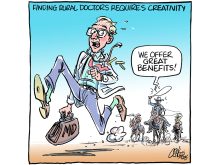Last month, Calgary Conservative Senator Ron Ghitter looked at the results of the six March 25 federal byelections and reached a depressing (for a Tory) conclusion.
As a separate entity, his political party may be doomed on the national scene.
Last week, Alberta Conservative premier Ralph Klein appeared to reach the same conclusion. He said Reform and the Progressive Conservatives should merge.
Across English Canada, the Reform party is in the ascendency as a right-wing alternative to the Liberals. The Conservatives’ recent futile competition for right wing votes merely weakens the cause and gives the Liberals a free ride.
Read Also

Kochia has become a significant problem for Prairie farmers
As you travel through southern Saskatchewan and Alberta, particularly in areas challenged by dry growing conditions, the magnitude of the kochia problem is easy to see.
Ghitter, in the pages of the Calgary
Herald, did not say the PC Party – the party of Confederation – should concede defeat. He merely noted that continued competition helps the Liberals and virtually guarantees their re-election in two years.
The March 25 byelections in Ontario, Quebec and Newfoundland support the point.
Having cut spending, forced thousands onto the unemployment lines, made life more difficult for students and the poor, and fumbled the unity file, the Liberals still managed to win five of the six mid-term byelections.
Usually, it would be a chance for voters not worried about electing or defeating a government to punish the louts who have been making their lives more difficult. Instead, the Liberals retained all the seats they had held. Why?
In part, it was because the right wing split the vote, although only in Toronto’s Etobicoke North would the combined Reform-Tory vote have defeated the Liberals, 46.7 percent to 46.4 percent.
The real opposition story, though, was the continued collapse of the Conservatives. Just two and a half years ago, the Conservatives ruled with a majority government in Ottawa. Today, after the 1993 election debacle, they sit in Ottawa with two seats out of 295.
Tory officials would like us to believe that 1993 was an anomaly, a reaction against Brian Mulroney and the ineptitude of successor Kim Campbell and her campaign team.
Yet March 25, with Mulroney making millions in the private sector, Campbell an asterisk in Canadian history and Tory leader Jean Charest relatively popular in the polls, Canadians didn’t consider the Conservatives a relevant option.
In the six ridings, close to 140,000 Canadians went to the polls. Just 7.5 percent of them voted Conservative.
So are the Conservatives who are trying to rebuild the party merely guaranteeing the Liberals will stay in power to the end of the century and beyond?
It is a question Tory true believers in Western Canada must be asking themselves. Can the Conservatives really rise above the level of spoilers?
Anyone who has spent more than one minute watching the Liberals must know that at the very least, they need an effective opposition.
Calgary Reformer Art Hanger might say they deserve a good caning.
Whatever the punishment of choice, this is not a government that deserves a free ride.
















